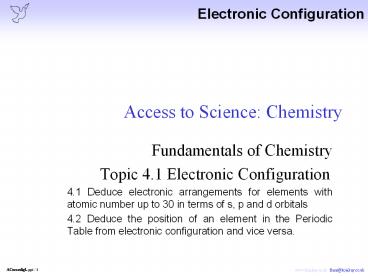Fundamentals of Chemistry - PowerPoint PPT Presentation
Title:
Fundamentals of Chemistry
Description:
... Fluorine Neon Sodium Magnesium Aluminium Silicon Phosphorus Sulphur Chlorine Argon Potassium Calcium Scandium Titanium Vanadium Chromium Manganese ... – PowerPoint PPT presentation
Number of Views:252
Avg rating:3.0/5.0
Title: Fundamentals of Chemistry
1
Access to Science Chemistry
- Fundamentals of Chemistry
- Topic 4.1 Electronic Configuration
- 4.1 Deduce electronic arrangements for elements
with atomic number up to 30 in terms of s, p and
d orbitals - 4.2 Deduce the position of an element in the
Periodic Table from electronic configuration and
vice versa.
2
Hydrogen
1s1
H
3
Helium
1s2
He
4
Lithium
2s1
1s2
Li
5
Beryllium
2s2
1s2
Be
6
Boron
2p1
2s2
1s2
B
7
Carbon
2p2
2s2
1s2
The next electron does not pair with the first
electron in 2p, but occupies the empty box
(orbital) to keep them as far apart as possible.
C
8
Nitrogen
2p3
2s2
1s2
N
9
Oxygen
2p4
2s2
1s2
Now that all 2p orbitals are filled the next
electron must pair up.
O
10
Fluorine
2p5
2s2
1s2
F
11
Neon
2p6
2s2
1s2
Ne
12
Sodium
2p6
3s1
2s2
1s2
Na
13
Magnesium
2p6
3s2
2s2
1s2
Mg
14
Aluminium
2p6
3s2
3p1
2s2
1s2
Al
15
Silicon
2p6
3s2
3p2
2s2
1s2
Si
16
Phosphorus
2p6
3s2
3p3
2s2
1s2
P
17
Sulphur
2p6
3s2
3p4
2s2
1s2
S
18
Chlorine
2p6
3s2
3p5
2s2
1s2
Cl
19
Argon
2p6
3s2
3p6
2s2
1s2
Ar
20
Potassium
2p6
3s2
3p6
4s1
2s2
1s2
K
21
Calcium
2p6
3s2
3p6
4s2
2s2
1s2
Ca
22
Scandium
2p6
3s2
3p6
3d1
4s2
2s2
1s2
Sc
23
Titanium
2p6
3s2
3p6
3d2
4s2
2s2
1s2
Ti
24
Vanadium
2p6
3s2
3p6
3d3
4s2
2s2
1s2
V
25
Chromium
2p6
3s2
3p6
3d5
4s1
2s2
1s2
Notice that one of the 4s electrons has been
transferred to 3d so that 3d is now a half
filled shell with extra stability. 4s and 3d
contain only unpaired electrons.
Cr
26
Manganese
2p6
3s2
3p6
3d5
4s2
2s2
1s2
Mn
27
Iron
2p6
3s2
3p6
3d6
4s2
2s2
1s2
Fe
28
Cobalt
2p6
3s2
3p6
3d7
4s2
2s2
1s2
Co
29
Nickel
2p6
3s2
3p6
3d8
4s2
2s2
1s2
Ni
30
Copper
2p6
3s2
3p6
3d10
4s1
2s2
1s2
Notice that again one of the 4s electrons has
been promoted to 3d so that 3d is now a
completely filled shell with extra stability.
Cu
31
Zinc
2p6
3s2
3p6
3d10
4s2
2s2
1s2
Zn
32
Alkali Metals
Group 1
All are ns1
33
Alkaline Earth Metals
Group 2
All are ns2
34
Halogens
Group 7
All are ns2 np5
35
Noble Gases
Group 0
All are ns2 np6
36
Transition Metals
First row are 3s2 3p6 3dx 4s2
but note chromium and copper































